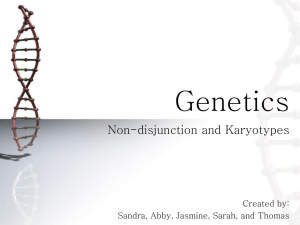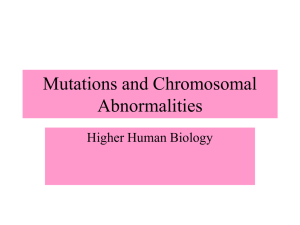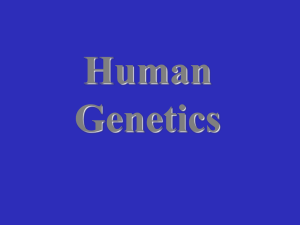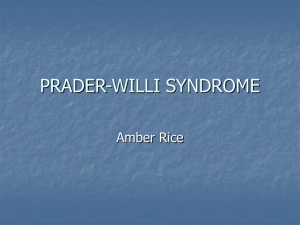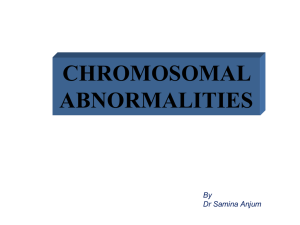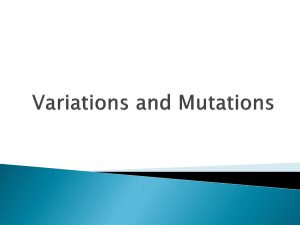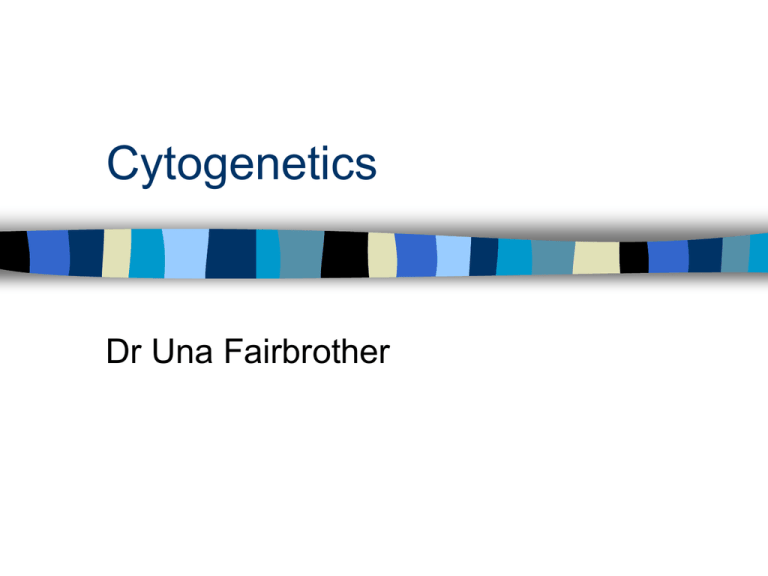
Cytogenetics
Dr Una Fairbrother
Mitosis
http://www.iupui.edu/%7Ewellsctr/MMIA/htm/a
nimations.htm
Identifying specific
chromosomes Centromere position
and arm ratios assist
in identifying specific
chromosomes
Many chromosomes
appear identical by
these criteria.
Identifcation
revolutionised by dyes
producing
reproducible patterns
of bands
Chromosome banding
Q banding:
chromosomes stained
with a fluorescent dye
such as quinacrine
G banding: produced by
staining with Giemsa
after digesting the
chromosomes with
trypsin
C banding:
chromosomes are
treated with acid and
base, then stained with
Giesma stain
Making a karyotype
Karyotypes are
presented in a standard
form.
First, the total number
of chromsomes is
given, followed by a
comma and the sex
chromosome
constitution.
This shorthand
description is followed
by coding of any
autosomal
abnormalities.
Preparing a karyotype
Metaphase cells required
any population of dividing cells could be
used.
Blood, cultured skin fibroblasts, bone marrow
cells.
lymphocytes induced to proliferate
many protocols but a standard series of steps
is involved
Karyotype protocol
blood + heparin to prevent coagulation
centrifugation through dense medium: red cells
and granulocytes pellet, no mononuclear cells
(lymphocytes and monocytes).
cultured for 3-4 days in (mitogen)
phytohemagglutinin, which stimulates
proliferation.
add colcemid- disrupts mitotic spindles and
prevents completion of mitosis.
harvested and treated with hypotonic solution:
nuclei swell osmotically, aids good spreads
cells are fixed, put onto a slide and dried.
stained to induce a banding pattern
Diagnosis of abnormalities
Several metaphases are processed to control
for artifacts ie extra or missing chromosomes.
Diagnose cases of mosaicism
Abnormalities in peripheral blood may need
to be confirmed in other tissues
Analysis of diseased tissues can provide
useful information.
E.g evaluation of cancers
Ploidy
Euploidy: normal number of structurally
normal chromosomes.
Euploid females have 46 chromosomes (44
autosomes and two X chromosomes),
Aneuploidy: less or more than the normal
diploid number
– Most frequently observed type of cytogenetic
abnormality.
Aneuploidy is recognised as a small deviation
from euploidy because major deviations are
rarely compatible with survival
Most common aneuploidies are
monosomy and trisomy
Monosomy: lack of one of a pair of chromosomes.
– A common monosomy seen in many species is X
chromosome monosomy, Turner's syndrome.
– Monosomy is usually lethal
Trisomy: a specific instance of polysomy.
– i.e. Down syndrome, three 21s.
Triploidy.
– Three of every chromosome
– 69 human chrs (3 haploid sets of 23),
– Due to fertilisation by two sperm.
– rare and such individuals are quite abnormal.
– survivers likely to be mosaic,
Chromosome abnormalities
Deletions occurs when a chromosome breaks
and a piece is lost.
Results in partial monosomy for that
chromosome.
Chromosome inversion cn occur after a
breakage
Chromosome fragment is inverted and rejoined
not lost.
Unless the breakpoints disrupt an important
gene, phenotype may be normal.
Chromosomal translocations
Translocations: chromosomes break and the
fragments rejoin to other chromosomes.
Many structurally different types of
translocations
No loss of genetic material but breakpoint can
disrupt a critical gene or juxtapose pieces of
two genes to create a fusion gene
Translocations cause reductions in fertility.
Reciprocal translocation
Two non-homologous chrs break
and exchange fragments.
Balanced complement of chrs
and normal phenotype
But subfertility due to problems in
pairing/ segregation during
meiosis.
Some offspring are Translocation chrs and their
cytogenetically normal homologs form quadrivalents.
Formation of unbalanced
Others carry the
gametes and offspring with
translocation of their
unbalanced genomes –
parent
Translocations are often lethal
thus heritable
Centric Fusions
A centric fusion is a
translocation in which the
centromeres of two
acrocentric chromosomes
fuse to generate one large
metacentric chromosome
Robertsonian
translocation
The karyotype carrying a
centric fusion has one
less than the normal
diploid number of chrs.
Centric fusions cause a
mild reduction in fertility
(5-15%), much less
severe than in the case of
reciprocal translocations.
Isochromosomes
A chromosome can split "the wrong way" in
mitosis (or meiosis II)
Both long arms remain attached and move to
one pole
Both short arms do likewise moving to the
other pole.
Isochromosomes are simultaneously
duplicated for the genes in the retained arm
and deleted for the genes in the other.
The prognosis is poor except for iXq
(isochromosome of the long arm of the X).
Ring chromosomes
Mutation removes both telomeres
Repaired by sealing the ends together
forming a ring chromosome.
Deleted for genes at both ends of the
chromosome.
The symtoms will depend on the extent of the
deletion.
Ring chromosomes are mitotically stable.
Chromosome abnormalities
animations
http://www.tokyo-med.ac.jp/genet/cai-e.htm
Mosaic
An individual with more than one
cytogenetically-distinct population of cells.
The fraction each genotype is variable
Large proportion of abnormal cells will
manifest disease.
Small number of normal cells may prevent or
reduce disease.
Most humans with Turner's syndrome (X
chromosome monosomy) die prior to birth.
Many survivers are found to be mosaics with
a substantial fraction of normal cells (e.g. 46
XX/45 XO mosaics).
X chromosome Mosaicism
X inactivation occurs randomly
Normal females have equal populations of
two genetically different cell types (type of
mosaic)
In half their cells, the paternal X is inactivated,
and in the other half the maternal X
chromosome is inactive.
Important biological and medical implications,
particularly in X-linked genetic diseases.
Why are chromosome studies
important?
Diseases caused by
missing/additional parts
of or whole
chromosomes
Downs syndrome plus
21
Cri du chat missing part
of short arm chr 5
Turners missing an X or
Y chr
Chromosomal Disease
1 in every 200 newborn children has a
chromosomal abnormality.
Some are phenotypically normal, while others
have manifestations of disease.
These children have ‘mild’ disorders
compatible with survival to term.
Half spontaneously aborted first trimester
fetuses are abnormal
In preimplantation embryos higher numbers
of abnormalities are seen.
Some chromosomal abnormalities are never
seen, because they are so profound
Causes of Chromosomal
Disorders
Ionising radiation,
autoimmunity, virus
infections and chemical
toxins in the
pathogenesis of certain
disorders.
Most cases of simple
aneuploidy - monosomy
or trisomy - are likely
due to meiotic nondisjunctions
Clinical presentation suggestive
of chromosomal abnormality
Infertility and sterility: Cytogenetic analysis of
such individuals is often warranted
Intersexes: genetic and phenotypic sex do
not correspond.
Multiple congenital malformations: seen with
many types of chromosomal abnormalities,
particularly deletions and aneuploidy.
Mental retardation: Well-known examples of
this are Down and fragile X syndromes.
Prenatal diagnosis
Amniocentesis:12 - 14 weeks of gestation
fetal cells from amniotic fluid is drawn off..
Chorionic villus sampling: 9-10 gestation,
placental tissue aspirated via the cervix,
A single cell from an 8 cell stage embryo can
be examined directly - used to decide on
which embryo to reintroduce into the mother.
How are abnormalities
diagnosed?
Normal karyotype
Down syndrome
karyotype
FISH good at identifying
abnormallities
Determines trisomies
and monosomies.
probes for specific
regions determine
deletions,
translocations, or
duplications
trisomy 21 (right),
a probe for
chromosome 22
detected a
translocation, to
chromosome 9 (left)
FISH technique
DNA probes are specific to
regions of individual chrs.
Probe attaches to the
spread of chrs
a fluorescein stain is
applied.
visible with the aid of a
fluorescent microscope.
The chr 21 pair have been
painted.
Fluorescent in situ
hybridisation
The tyramide signal
amplification technology uses a
fluorescent tyramide and HRP
Probe is labeled with biotin
and detected by streptavidinHRP or an antibody.
HRP reacts with a fluorescent
tyramide in the presence of
hydrogen peroxide to produce
a reactive tyramide that
attaches to proteins in the
area.
The turnover of multiple dyelabeled tyramide substrates per
peroxidase label results in
strong signal amplification.
FISHing for AS and PWS
Metaphase FISH
Detect microdeletions beyond resolution of
routine cytogenetics
Identify extra material of unknown origin.
Determine a simple deletion or a subtle or
complex rearrangement.
Detect specific rearrangements in certain
cancers.
Number of microdeletion syndromes
diagnosed by FISH is expanding rapidly.
Probe may be specific for the gene as in
Williams Syndrome
a deletion has been shown in the elastin
gene in 96% of individuals with a firm
diagnosis.
Microdeletion Syndromes
Currently Diagnosable with FISH
Cri-du-Chat
Miller-Dieker Syndrome
Smith-Magenis
Syndrome
Steroid Sulfatase
Deficiency
DiGeorge/Velo-CardioFacial/CATCH22/Shprintzen
Syndrome
Kallman Syndrome
Williams Syndrome
Wolf-Hirschhorn
PraderWilli/Angelman
Syndrome
Interphase FISH
Determine the chr number
Specific rearrangements in certain cancers.
Advantage is that it is rapid
Aneuploid Screen on amniotic fluid cells
Nuclei denatured and hybridized with probes
for chromosomes 13, 18, 21, X, and Y and
results usually obtained within 24 hours.
Routine cytogenetics is included to confirm
the results or detect any abnormalities not
detected by interphase FISH.
Aneuploid Screen test:
Interphase FISH
Top nucleus chr 13
(green), and 21 (red).
Bottom nucleus probed
for chromosomes 18
(aqua), X (green), and Y
(red).
two signals each for chrs
13, 18, and 21 and one
signal each for the X and
Y
fetus is normal male with
respect to the Aneuploid
Screen test.
Metaphase cell
probed for
DiGeorge/Velo-CardioFacial/CATCH
22/Shprintzen Syndrome
caused bymicrodeletion
on chr 22.
dual-color mixture of two
probes
Green- an internal control
at 22q13.
red -at the DiGeorge
region 22q11.2.
this individual would not
have DiGeorge
Syndrome.
Did chr 4 have a small
terminal deletion at 4q?
or was there a more complex
rearrangement?
Top:hybridized with a
"painting" probe for chr 4
Bottom:hybridized with a
probe for 4q ter
only one green signal this
confirms that one chr 4 is
missing material from t 4qter
example of routine
Cytogenetics and FISH can
be used together
Steroid Sulfatase Deficiency
caused by a microdeletion
on the X
two probes for the X
chromosome, both red in
color.
"X cen" control located at
the X centromere.
"Xp22.3" probe is for the
Steroid Sulfatase region
at Xp22.3.
this is a female carrier for
Steroid Sulfatase
Deficiency.
Multicolour FISH
Can use probes of
different colours to
identify different all
chromosomes at once
Chromosome
rearrangement in an
oral cancer cell shown
with multi-colored
painting probes.
Detecting cancer causing viruses
BAC to paint
Research application
Chromosome breakpoints
identified by our technique of
paint-assisted
microdissection fluorescence
in situ hybridisation (PAMFISH, at left)
breakpoints are mapped in
greater detail using bacterial
artificial chromosome FISH
(BAC-FISH, at right)
FISH and chips
Microarray/biochip-based
technologies
In cytogenetics, promises to speed up detection of
aberrations now detected by FISH.
Whole genome expression array and direct molecular
analysis without amplification.
Analysis of single-cell gene expression promises a
more precise understanding of human disease
pathogenesis and has important diagnostic
applications.
Optical Mapping can survey entire human genomes
for insertions/deletions,
– which account for more variation between closely-related
genomes than SNPs
– major cause of gene defects.
Molecular imaging technologies
Optical imaging, magnetic resonance imaging (MRI) and
nuclear medicine techniques.
Positron emission tomography (PET)- technique for
imaging molecular pathways in vivo in humans.
Cytogenetics refined by nanotechnological applications
at single molecule level i.e single molecule imaging.
Atomic force microscope (AFM) is well-established for
imaging single biomolecules under physiological
conditions.
Scanning probe microscope (SPM) is important for nonintrusive interrogation of biomolecular systems in vitro
and have been applied to improve FISH.
QD (quantum dot)-FISH probes, which can detect down
to the single molecule level.
Why Do We Need Array
CGH?
Current cytogenetic genome
screen - karyotyping - even
the best has low resolution
(5MB)
FISH – better resolution
(3MB), but only targeted
regions
Molecular techniques struggle with larger sized
fragments and whole
genome analysis
What are Microarrays?
CGH BAC Micoarray – How
Does it Work?
Patient DNA + Cot-1 DNA + Reference DNA
Labeled with Cy5
Labeled with Cy3 Unlabeled
(Detected with Red Laser)
(Detected with Green Laser)
Glass slide spotted with DNA from known
locations in the Genome
Test Sample
Test
Reference
Cy5
Exp. 1
Test
Cy5
Cy3
Exp. 2
pter
Cy3/Cy5
Ratios
qter
The Scanner Images the Array
Cy3 Image
using a green laser
Cy5 Image
using a red laser
Reading a CGH-Microarray
The resulting “colour” of a spot will depend on the ratio
of “Red” and “Green” labeled DNA which has Hybridized
to the Spot
Equal
Excess Patient DNA
(Duplication)
Loss of patient DNA
(Deletion)
Composite Image of Individual
Block
Detail of array
showing a
possible deletion
Molecular Karyotype
Linear position of
changes marked on
the chromosome
Clone location is
displayed
Statistically significant
replicate analysis
Confirmation
Usually done by
FISH
Examples of Applications
First used in cancer to look at
differences between original and cancer
cells in the same patient
Then used to look for chromosome
imbalance
Does not detect balanced
rearrangements (e.g. reciprocal
translocations)
Chromosome Polymorphisms
Most of variations are in repetitive
regions
All are considered normal since there is
no obvious phenotype
Not of too much interest to cancer
workers
A real problem for clinical geneticists
Current Uses of Array CGH
Define congenital genetic defects
Define acquired genetic changes (in
cancer)
Molecular fingerprints of specific tumors
and subtypes
Identification of novel chromosomal
regions for drug targets and new
treatments
Further Reading
Cooper CS (2001) : Applications of
microarray technology in breast cancer
research. Breast Cancer Res. 3:158-175.
Review
Buckley, et al. (2005) Copy-number
polymorphisms: mining the tip of an iceberg.
Trends in Genetics 21:315-317


